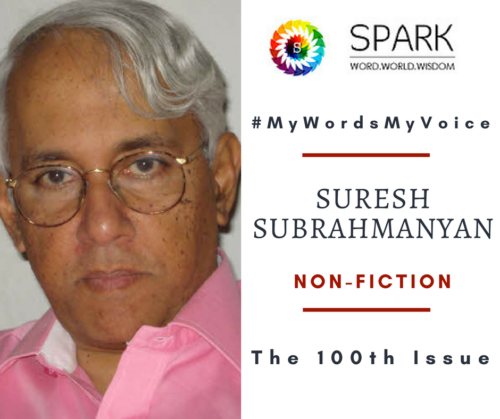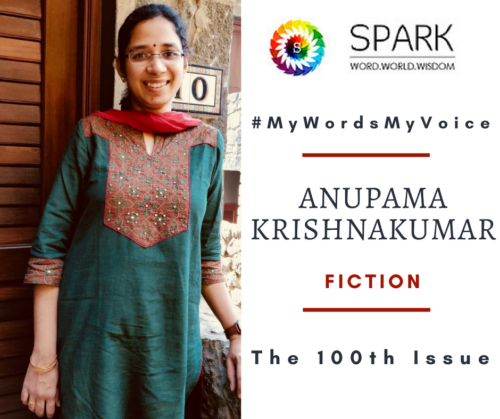by Suresh Subrahmanyan
What theme are you addressing in your piece? Why is this important to you?
Suresh Subrahmanyan: My piece for this special issue of Spark deals with the subject of Exhibitions. More specifically, the trials and tribulations of actually visiting an exhibition or fair in India. The subject is of special interest to me because all my life, I have been attending exhibitions either in my personal or professional capacity – in India and abroad. It is not something I have particularly enjoyed doing, for the most part, and I have tried to explain why in a diverting and humorous way. The subject’s importance stems from the fact that no one appears to have dealt with this human, quotidian and somewhat tiresome aspect of exhibitions in a light hearted way before. This is a left field look at exhibitions and is in no way intended to belittle its overall importance or the pleasure and profit it may bring to others.
At exhibition openings always praise the chicken for laying eggs; you can wring its neck later.
– Bill Jay (1940 -2009), British photographer and curator.
At the outset, I offer my apologies in advance to all ‘exhibitionists’, for what is about to follow. And a further expression of regret for that weak pun on the word ‘exhibitionist’. The point, or pun, at issue is that I abhor exhibitions. And fairs. With equal certitude and vehemence, I can also add to that dreary pair, carnivals, fetes, jamborees and by stretching the point, theme parks, Water Worlds, Disney Worlds, Appu Ghars and the like, which would nicely complete this agglomeration of supposedly educative and improving diversions that is thrust on the body politic by all manner of bodies all over the world.
At this juncture it would be appropriate to trot out a few laudable exceptions that may broadly fall under the umbrella of exhibitions, but with a difference – art galleries and by extension, one off displays of the works of famous or not-so-famous artists, be they sculptors, painters, photographers or specialised, subject specific exhibitions like vintage cars, railway engines through time, the history of wine-making and so on. The latter list comes under a more refined category to be enjoyed in a controlled environment, as opposed to the former, under open skies with plenty of noisy children, ferris wheels, strolling clowns, cotton candy vendors, tight rope walkers, magicians, fortune tellers in tents, chaat stalls and eateries of every conceivable description. Always the eateries, doing roaring business as compared to spaces that bend the mind. In short, the kind of ambience where Hollywood murders and Poirot whodunits usually occur, prime suspect being the clown on stilts.
I have attended crowded book fairs in Calcutta, so ill-planned that it is virtually impossible to seek out genres or authors that most interest you. You kind of walk into a stall, any stall, and just take potluck. A question to the illiterate stall minder like, ‘Do you stock Wodehouse?’ is most likely to elicit a response such as, ‘Which house?’ At which point you swiftly move on to the next stall. Book fairs in our country are generally to be classified as a noble idea, poorly executed. I am not suggesting there are no exceptions, but they only serve to prove the rule. Book fairs are not to be confused with the Lit Fests (almost every city now has one), which are well organised with a plethora of high profile authors and publishers holding forth on a number of subjects. And the big publishers display their wares with a great deal of thought and marketing savvy at these literary festivals. The truncated branded acronym, Lit Fest, is an offensive blot on the literary landscape.
Now that a clear cut, if over-simplified distinction has been made between bad exhibitions and good exhibitions, we can press on and delve into what it is about exhibitions and fairs that unfailingly gets up my nose. It starts with the car parking. Hundreds of cars vying for parking space which is nearly always (dis)organised in a higgledy-piggledy fashion. After crawling through the car queue at less than the proverbial snail’s pace, a process that could take up to three quarters of an hour, you finally slide out of the vehicle with the rest of your entourage. Only to be confronted with what appears to be another half hour’s trudging through heat and dust to the exhibition site. If you haven’t been sick all over your shirt front from dehydration or collapsed out of heat exhaustion in the interim, you will find yourself standing in an interminable line for entrance tickets. Bearing in mind that it’s been a touch over two hours since you left home.
After paying a prince’s ransom, relatively speaking, for the tickets, you are then frisked, felt and patted all over your body, make that another fifteen minutes, and now are finally free to roam as you please. Naturally, after the exertions you have been through to merely enter the exhibition arena, you are close to starving and dying of thirst. Spots are starting to float in front of your eyes. So your first stop inevitably must be an eatery. This is not quite as simple as it sounds. The food stalls are long and endless and the cuisine mind bogglingly confusing. Chinese, Japanese, Malaysian, Vietnamese, burger joints, pasta joints, Indian cuisine from every corner of our vast and spicy nation, you are completely spoilt for choice.
Problem is every stall is full. It’s almost as if the huddled masses have gone to all this trouble just to tickle their taste buds and take a conducted tour de la gastronome – to coin a phrase. This is perfectly understandable after the ordeal one has been through just getting there. A sense of accomplishment after an arduous obstacle race, and the stomach commands you to ‘Go forth and hog’. Which leaves you scratching your head on many levels, metaphorically speaking. What should one eat, which particular cuisine catches your fancy at that particular moment in time, questions like these take on almost metaphysical proportions. Frankly, given that your tummy is growling in angry protest, pretty much anything will do and being picky is a futile luxury you can ill afford. Fact is, when you finally bite into a chicken tikka masala roll (washed down with a large swig of Coke), and your hunger partially sated, your neighbour gorging on his Burmese Khao Suey or Japanese Sushi invariably appears to have made a better choice. At least, it looks that way. It is one of the eternal verities of life – the person sitting next to you always orders something more delicious than you have. If it is of any consolation, your companion feels pretty much the same way about your order!
As to the actual exhibition itself, if you can tear yourself away from the food stalls, generally you attend these affairs because some dear friend or business associate of yours is showing his or her wares and you feel honour bound to attend. Quite recently, a very close friend of ours, an immensely talented practitioner of a very specialised Japanese art form called Sumi-e / Suiboku-ga (charcoal ink and brush on handmade paper being the primary tools and medium), was showing her work at an exhibition supposedly highlighting Japanese art and craft. Her little stall drew great appreciation and plaudits from a number of people who milled around the exhibits, tastefully displayed. My wife and I felt happy and proud that our physical effort to get to the venue was well rewarded. We did the usual mobile phone photography of the exhibits and took grinning selfies, instantly posting them on Facebook, followed by much hugging and hand shaking, and then decided we will take a quick dekko at the rest of the exhibition before making tracks home.
From an exhibition intended to promote Japanese art, you expect a level of finesse and attention to detail in terms of display and overall planning of the layout. Something the Japanese are noted for. You certainly do not expect Cup Noodles to be rubbing shoulders with a delicate showing of Ikebana flower arrangement. However, that was precisely what happened. There were other stalls as well, where things to eat (presumably of Japanese origin) were vying for attention with genuine artistic offerings of the same provenance. Naturally many of the visitors were busy crowding the food stalls while genuine art appreciation went out of the window. A cultural programme was also on at full blast at the adjunct auditorium. It was all a bit of a mishmash. Perhaps the Japanese boffins responsible for putting this exhibition together, felt that in India, first take care of the gourmand, and the gourmet will automatically follow. And make sure there’s plenty of noise. I was careful not to be too critical at the venue. The last thing you want is some hyper-sensitive Japanese organiser kneeling down right in front of you and disembowelling himself in an atoning act of hara kiri!
It is my fervent belief that things to eat must always be placed distinctly away from things to see. Otherwise, the wandering and weary on-lookers needs must gravitate towards the appetising smells that waft and assail our olfactory senses and taste buds. In addition to all this, people kept thrusting all manner of leaflets at you, advertising restaurants, hair stylists and reiki classes.
As I told my friend, the estimable practitioner of the rare and delicate Japanese art form of Sumi-e, next time round she must insist on a more friendly and suitable environment where true art can be enjoyed for its own sake. And not merely for the saké.






